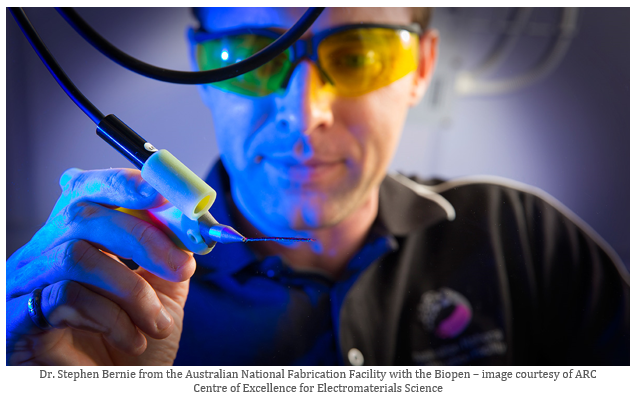The dream of using 3D printing technology to regenerate damaged or diseased tissues faces a number of technological and biological challenges, not the least of which is providing the new tissues with just the right amount of a complex mix of proteins referred to as growth factors needed for development of stem cells after implantation.

Controlling the delivery of these growth factors is critical to sustaining the stem cells that need up to six weeks to grow into tissues such as cartilage, bone or muscle. Releasing the growth factors too fast or too slowly can result in failure of the tissue to engraft.
To solve this problem, Lillith Caballero Aguilar, a PhD candidate at the Swinburne University in Melbourne, Australia is encapsulating the growth factors in polymer microspheres that can be loaded like ink into a “biopen,” which permits a surgeon to ‘draw’ biomaterials directly into a patient where the microspheres slowly release the growth factors to help the tissue grow.
She uses the emulsion method of shaking an oil and water solution at an intense rate to create the ‘microspheres’. These microspheres are then cross-linked to form a substance that can hold the growth factors. The spherical shape ensures consistency and predictability allowing the polymer to be added to 3D printer ‘ink.’
In a collaboration with researchers at St. Vincent’s Hospital, Melbourne and the university of Wollongong, Aguilar and Professors Gordon Wallace and Jeremy Crook at the University of Wollongong, are developing the biopen printer to eventually be used by a surgeon to directly print skin, or bone, muscle or other tissues.
In an Animal Clinical trial published online in the August 2017 Journal of Tissue Engineering and Regenerative Medicine, the team used the biopen to implant bioscaffold and cultured cells directly into injured cartilage in sheep. They assessed the ability of the biopen to repair full-thickness chondral defect, the cartilage that covers the ends of bones. They compared three approaches for making the repair to a group of untreated controls.
A variety of tests 8 weeks after surgery showed no intra- or postoperative complications, and the bipen allowed early cartilage regeneration, showing that real-time, in vivo bio-printing with cells and scaffold is a feasible means of regenerating articular cartilage.
Whether you are an inventor or a company working to develop medical solutions using additive manufacturing, Kapstone has the experience and expertise to help you rapidly develop and commercialize any aspect of medical device manufacturing including additive manufacturing processes. For more information, contact us today at (704) 843-7852 or email us directly at info@kapstonemedical.com.
Sources: Swinburne University of Technology and University of Wollongong press releases


